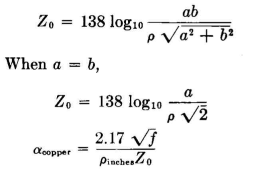| Radio Antenna Engineering is a free introductory textbook on radio antennas and their applications. See the editorial for more information.... |

|

Home  Radio-frequency Transmission Lines Radio-frequency Transmission Lines  Useful Transmission-line Configurations Useful Transmission-line Configurations  Four Wire Four Wire  Four-wire Cross-connected Balanced Feeder Four-wire Cross-connected Balanced Feeder |
|||||||||||||||||






|
|||||||||||||||||
|
Four-wire Cross-connected Balanced FeederAuthor: Edmund A. Laport This type of transmission line (Fig. 4.26) has a smaller external field than the equivalent side-connected line and therefore has lower pickup when used with directive receiving antennas.47 For the same dimensions it has lower characteristic impedance but higher copper loss.
The insulation loss would be about proportional to the relative characteristic impedances, but since more insulators in parallel are required in its construction, the over-all insulator losses are usually greater. It is therefore not as desirable for transmitting purposes as the four-wire side-connected line using the same amount of copper. Its principal utility is for receiving. A large-scale application of this type of line for receiving is shown in Fig. 4.95, where they connect several fishbone and rhombic receiving beam antennas with the diversity receivers in the station building. When h >> a, b, h
Two sets of values for this type of line are given here for reference:
|
|||||||||||||||||
Home  Radio-frequency Transmission Lines Radio-frequency Transmission Lines  Useful Transmission-line Configurations Useful Transmission-line Configurations  Four Wire Four Wire  Four-wire Cross-connected Balanced Feeder Four-wire Cross-connected Balanced Feeder |
|||||||||||||||||
Last Update: 2011-03-19




